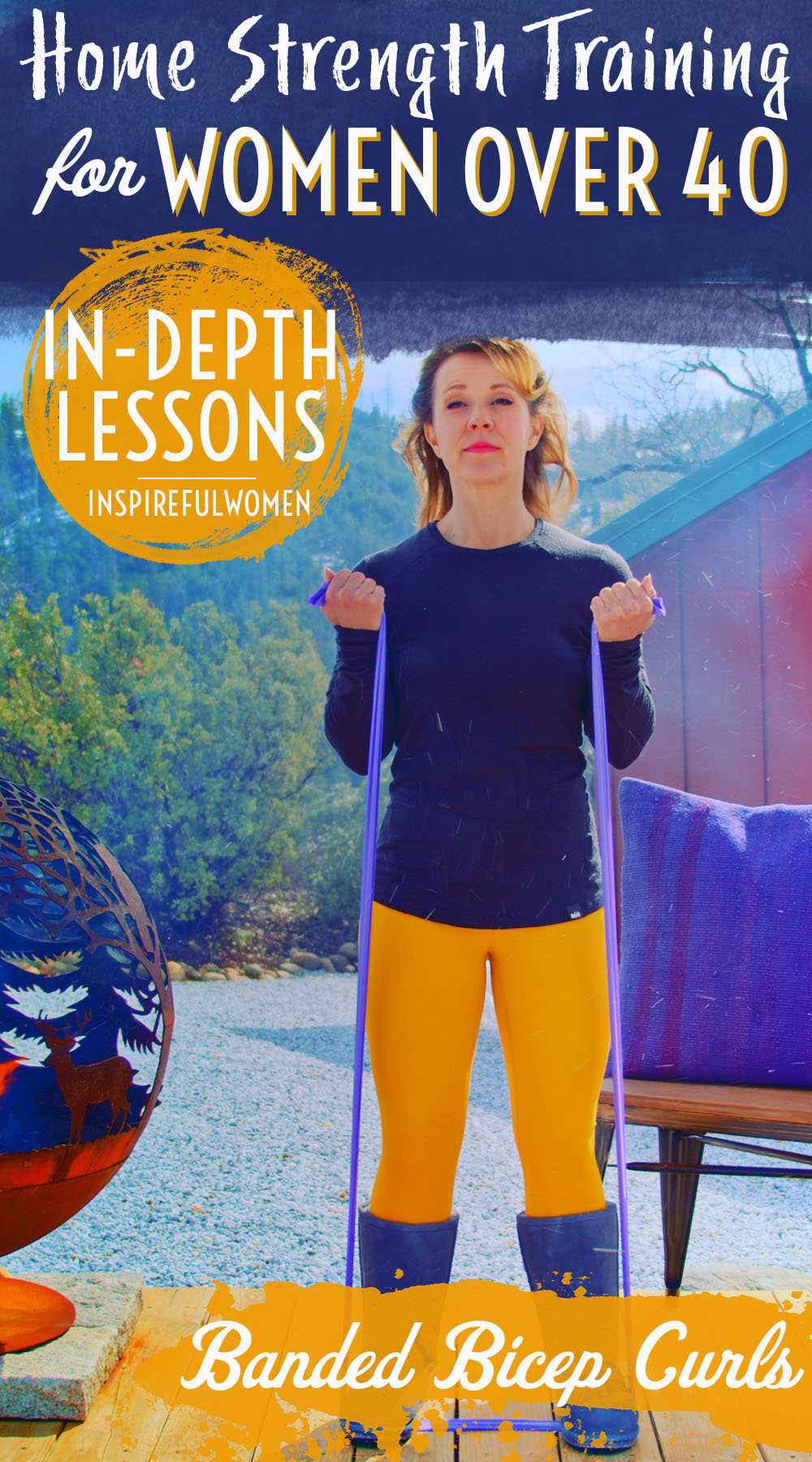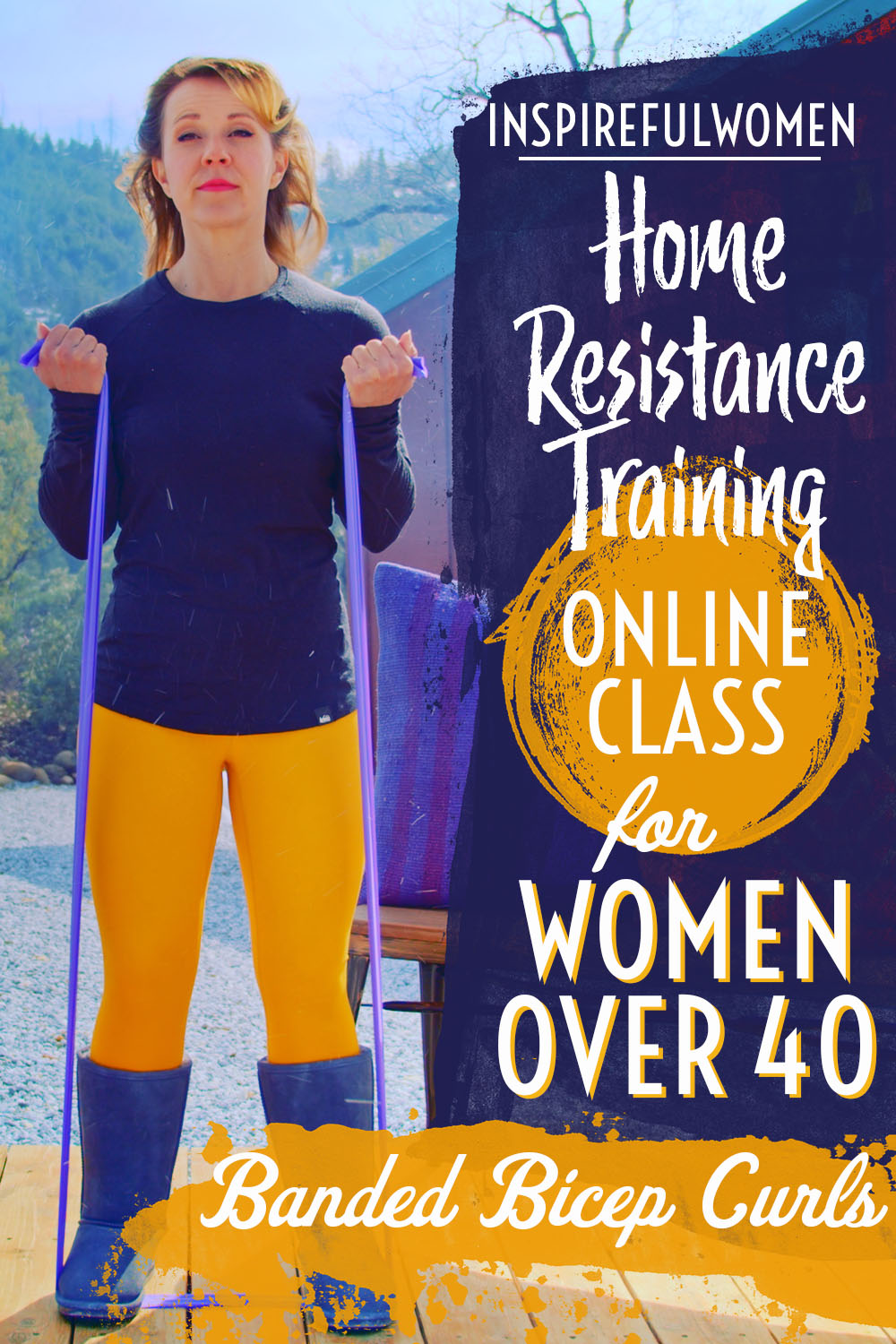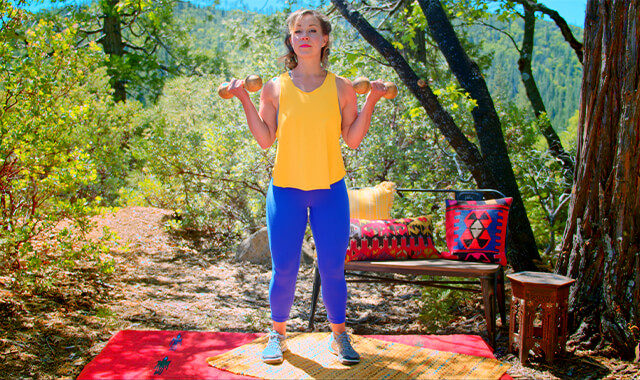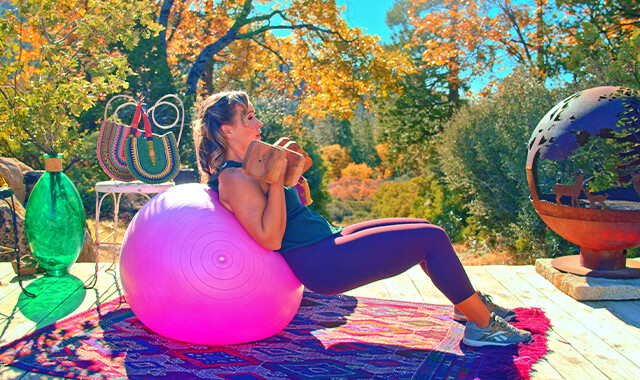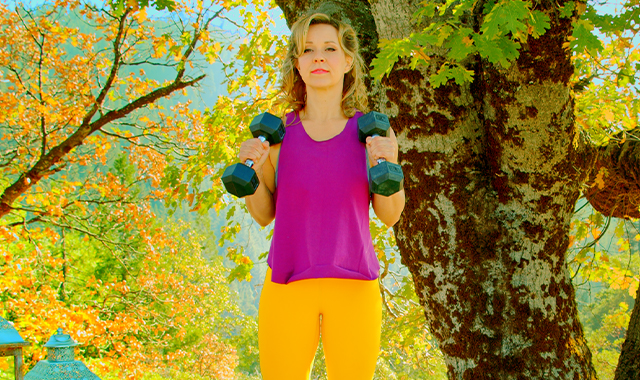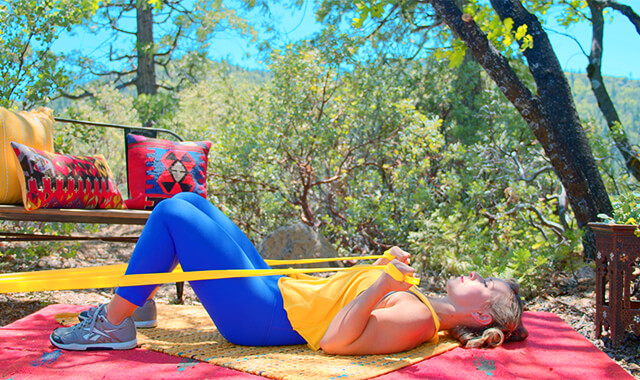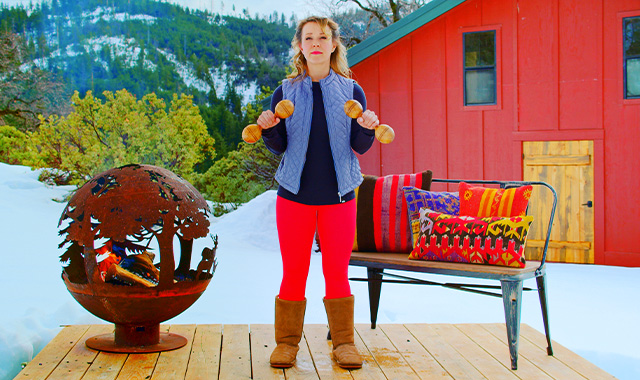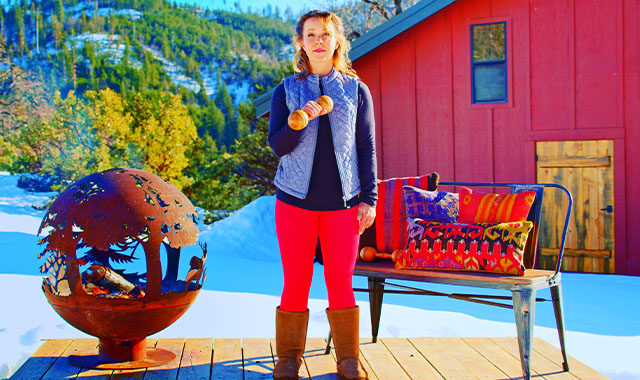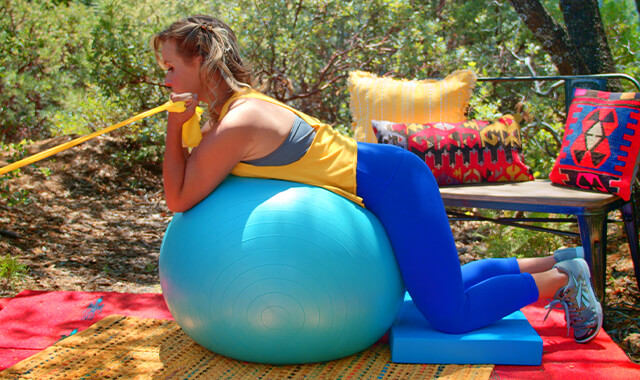Band Bicep Curl
How to Do the Band Bicep Curl | In-Depth Guide [VISUAL LEARNERS] Beginner
Proper Form, Common Mistakes, & Variations + Harder | Home Resistance Training
WHAT DO YOU WANT TO SEE?
QUICK DEMO
QUICK DEMO
MUSCLES THIS WORKS
MUSCLES
MAIN MUSCLES WORKED IN Band Biceps Curls
BICEPS BRACHII
OTHER MUSCLES WORKED:
- Forearms (supinator)
- Brachialis
STARTING POINTERS
Starting Pointers
WHAT WE'RE DOING TODAY
Other names for this exercise: Resistance Band Arm Curls
ALL WE'RE DOING:
Basically, bend your elbows.
This is a variation of the standard standing bicep curl exercise but using a resistance band. The movement is bending (flexing the elbow) while the forearm is rotated palm up (supination) to target the two main functions of the biceps muscle.
Using a band will change where the muscle is most active. When dumbbells are used the biceps will have to work hardest when the forearm is parallel to the floor. With the resistance band, the resistance increases as the band is stretched more, this will put the greatest load on the biceps at the end of the movement - when the elbow is most bent. The biceps is stronger around the mid-range - the range where the forearm is closer to parallel to the floor when the elbow bends more than the other elbow flexors (the brachialis and brachioradialis) will most likely start working harder to help out.
HOW TO DO THE EXERCISE
LOOKS
HOW Band Biceps Curls SHAPE OUR BODY
Bicep curls will tone and give you muscle definition in the front of your upper arm (where your bicep is haha!)
It helps give a curvy yet FIRM sculpted look to the arm.
PROPER FORM
PROPER FORM: Band Biceps Curl
EQUIPMENT, SETS & REPS
EQUIPMENT
Main set (3: Light/Med/Heavy)
X-Heavy Band (I recommend getting this too if you plan to use resistance bands frequently).
SUGGESTED STARTING WEIGHT FOR WOMEN:
Moderate resistance bands
SETS & REPS:
2 sets of 8-10 reps
PACE:
Quick up and slower down.
BODY POSITION
BODY POSITION FOR THE Band Biceps Curl
BAND: Secure the band under both feet.
FEET: Standing with feet shoulder-width apart, knees slightly bent
BODY STANCE: Neutral spine, shoulder blades in and down the back, sternum lifted.
HAND/GRIP: Neutral grip, holding one end of the band in each hand. The band enters the hand on the side of the little finger, crossing the palm to the thumb side.
ARM: Arms begin at your side hanging straight down.
NECK: Neutral and relaxed.
HOW TO DO
HOW TO DO Band Bicep Curls
CUE: Try to squeeze the hands in towards the shoulders as you pull the band up. Isolate the movement to the elbows.
Keeping the upper arms still, bend the elbows (flexion).
As the elbows bend, rotate the forearm so that the palm of the hands faces up to the ceiling (supination).
Continue to pull the hands up as far as you are able with good form and no discomfort.
Pause at the end and squeeze the biceps.
Slowly straighten the elbows and rotate the forearm so that the palms face in again.
Begin the next rep.
HOW TO SAFELY GET OUT OF THE EXERCISE
From the starting position, release the band.
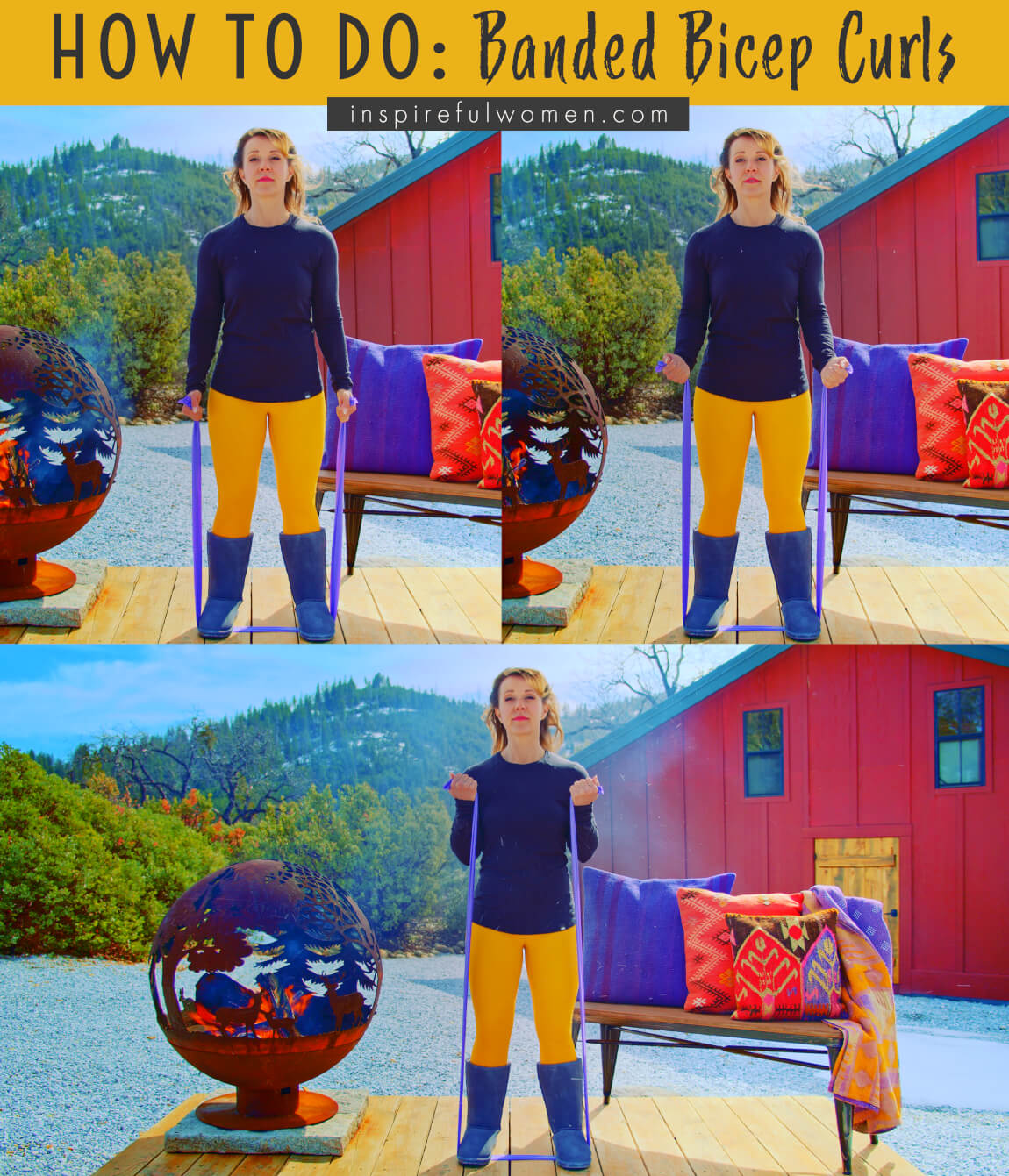
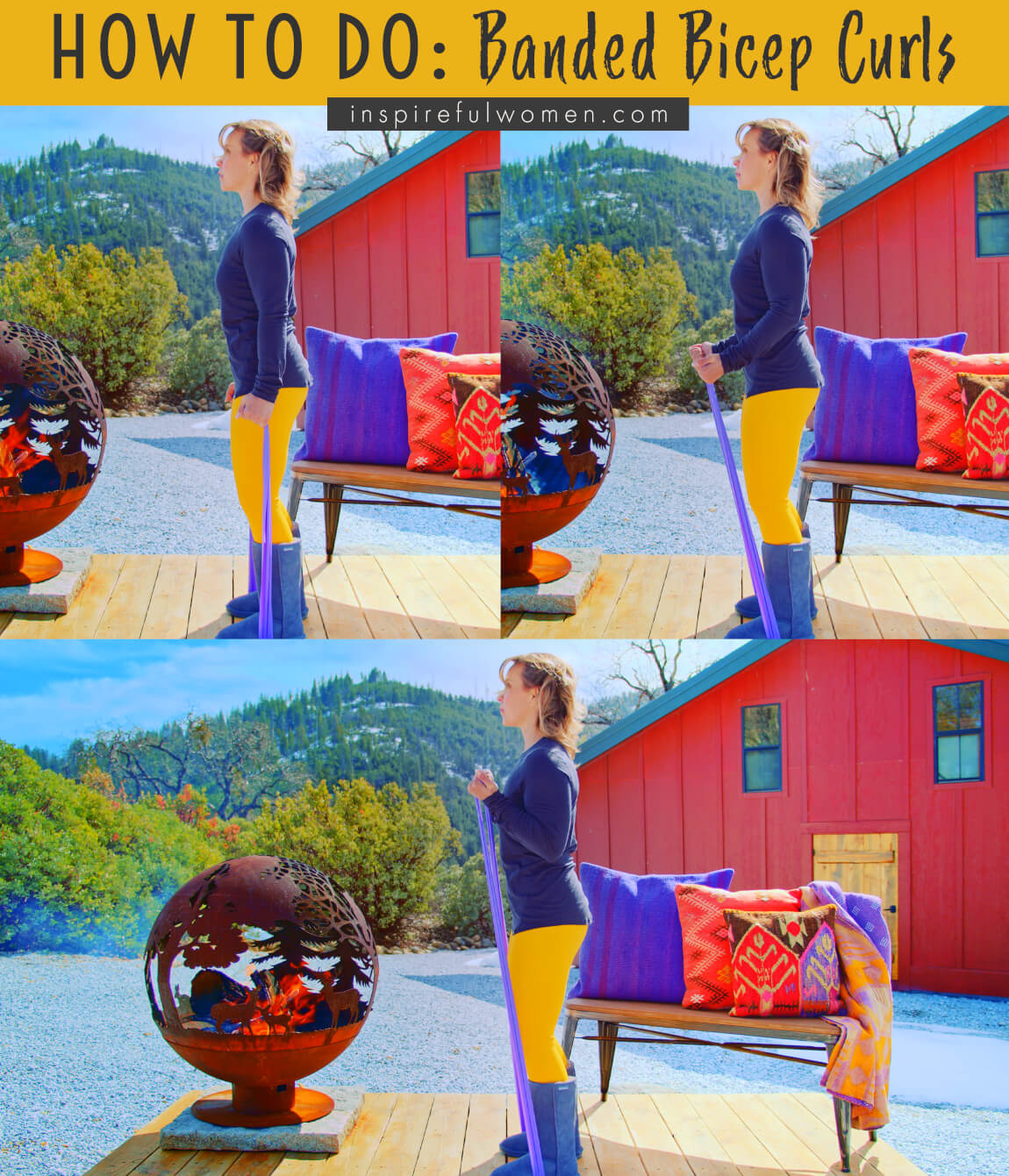
COMMON MISTAKES
COMMON MISTAKES
WHAT TO AVOID WITH THE Band Biceps Curl
KEY TIP:
Guess what? Good news! Many avoids are the same for most movements. Once you learn the basics, there's really only a few extra avoids for each individual movement.
1. Avoid shoulders hunching up
AVOID: Avoid hunching the shoulders up towards the ears.
WHY NOT?
- You're just not working the bicep muscles when you do this, that's all. This gets your upper traps (muscles to the sides of your neck where your bra straps usually lay) more involved.
WHAT TO DO:
- You will note decreased space between the shoulders and earlobes.
- Pull the shoulders down to keep the space between the ear and the shoulder during the entire rep - this opens up the shoulder to avoid tendon irritation and decreases the activity of the upper traps.
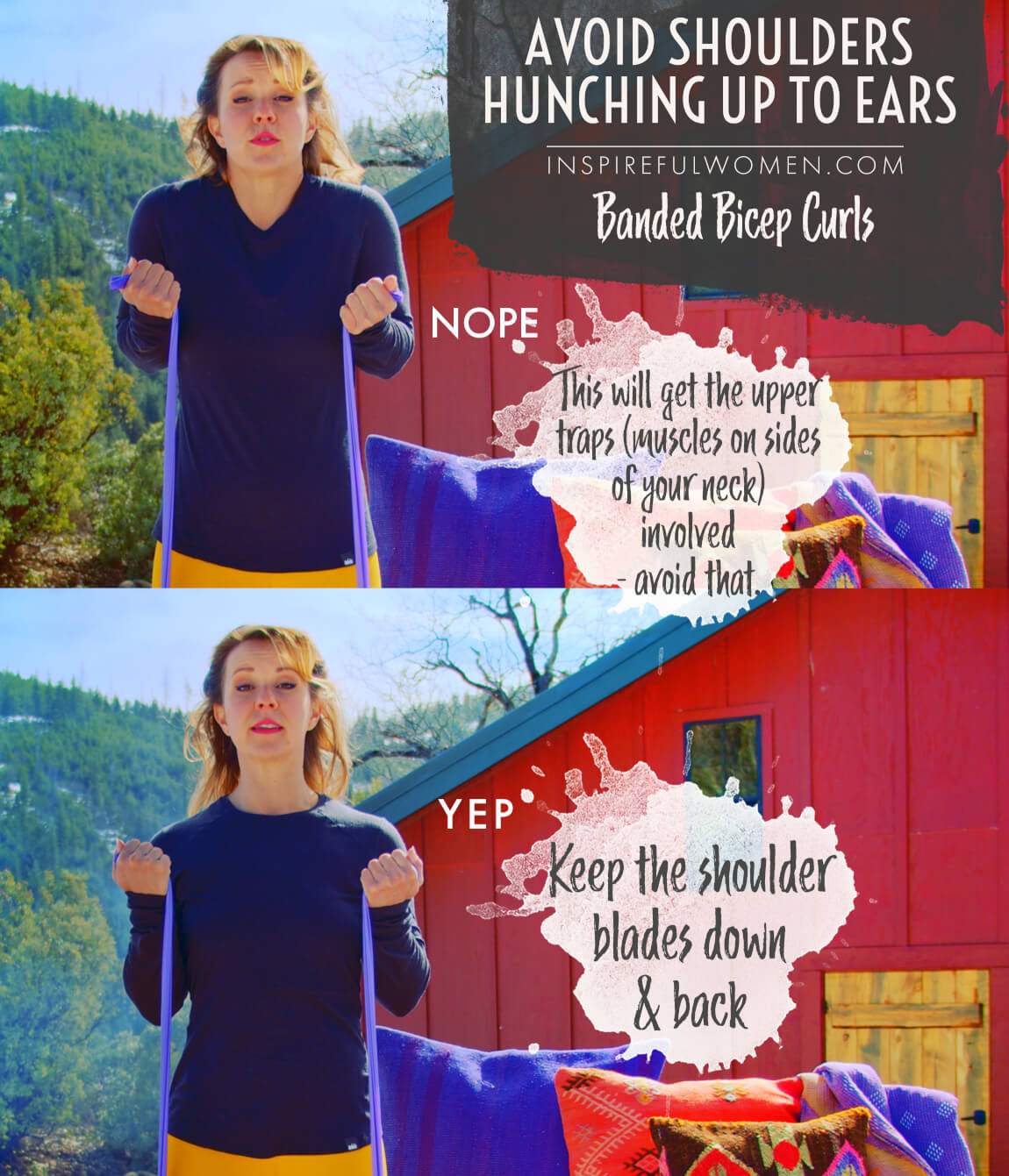
2. Avoid elbows flaring out
AVOID: Avoid letting your elbows move out to the sides.
WHY NOT?
- This will change the downward pull of gravity and will increase the activity of the shoulder.
WHAT TO DO:
- The upper arm should be resting on your sides, not moving.
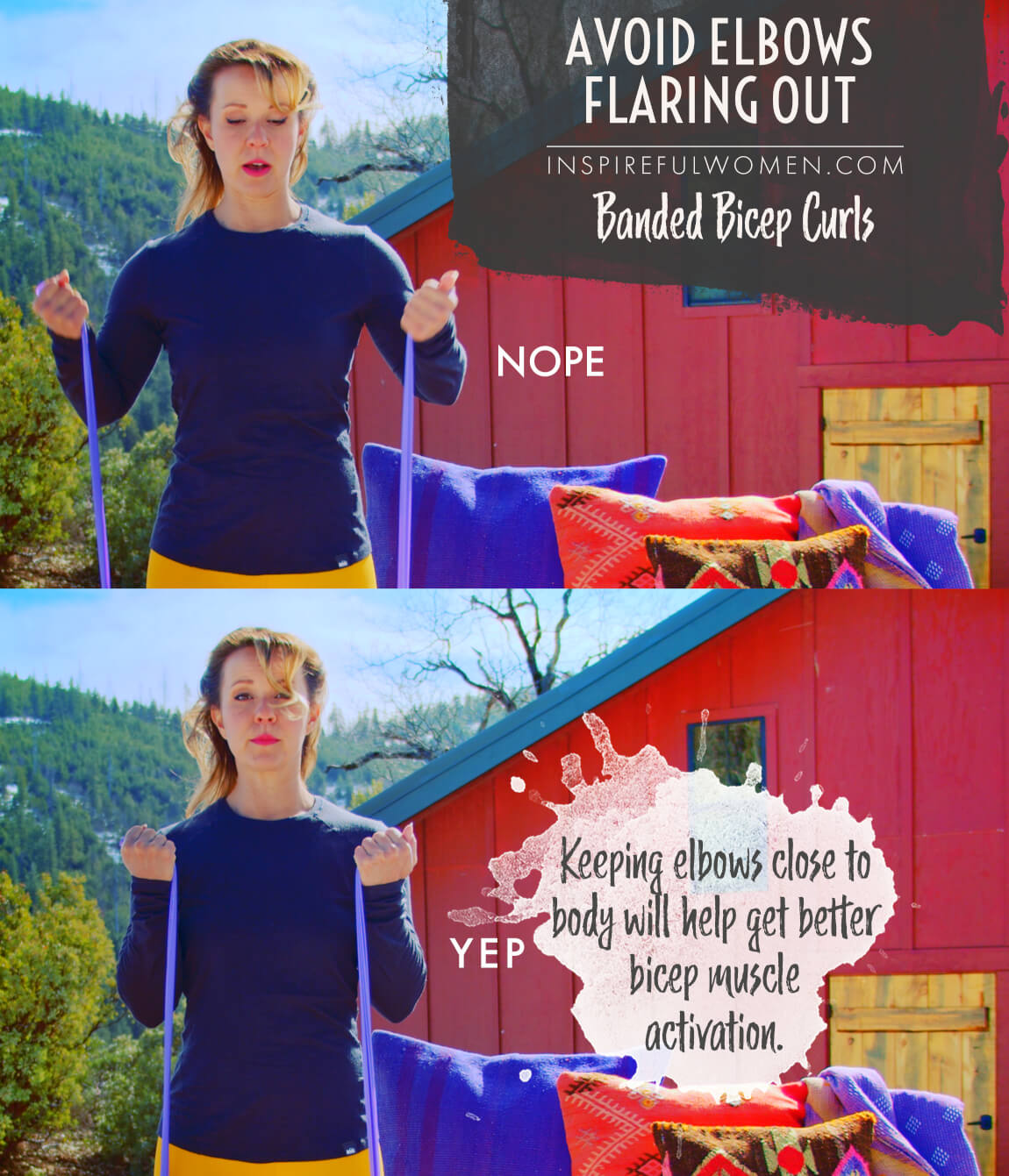
3. Avoid rounding shoulders
AVOID: Avoid rounding the shoulders forward.
WHY NOT?
- This means that you are trying to use the anterior deltoid and chest muscles to help bend the elbow.
- This can decrease the space between the shoulder blade and the upper arm bone (humerus) and irritate the tissues.
WHAT TO DO:
- Pull the shoulders blades in and down the back, lift the sternum to correct your posture.
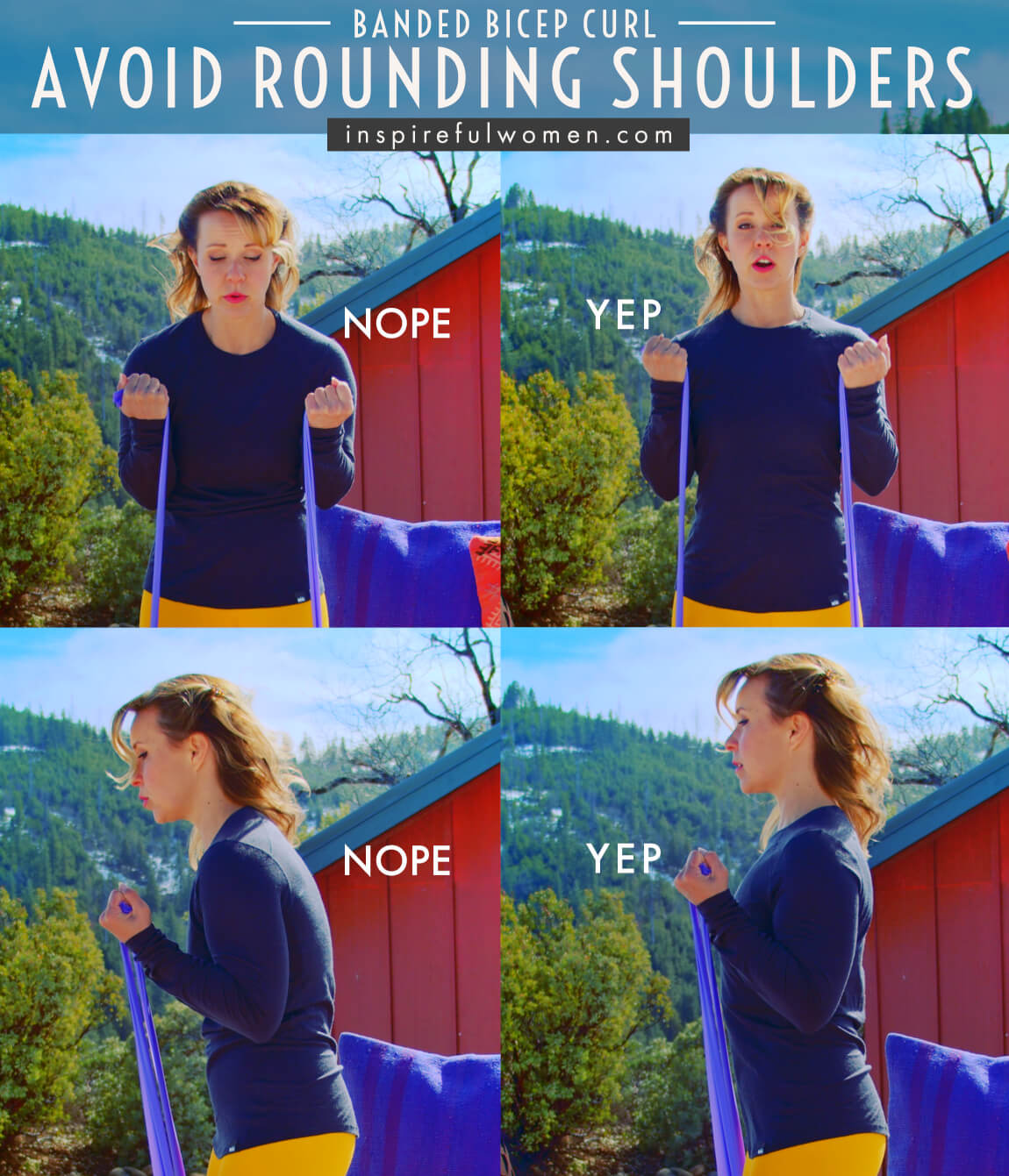
4. Avoid elbows behind body
AVOID: Avoid elbows behind body.
WHAT TO DO:
- Elbows should stay in line with the torso.

5. Avoid bending neck
AVOID: Avoid bending neck.
WHY NOT?
- If you bend your neck down as you lift, this will put strain on your neck.
WHAT TO DO:
- If you find that you cannot disengage your neck try tightening your ab muscles.
- The physical therapists' note on this: "I believe that the reason that you bring your head forward is that the brain thinks of goals when it programs the movement. The goal is to get the weight upward. The brain tries to do this the easiest way possible. So as the muscle fatigues the brain just lowers the head downward to achieve the goal without having to lift the arms any higher. I don't think you will hurt yourself doing this (it is not like extending the neck - that would cause issues down the road) but I do think it is a compensatory motion that should be avoided because you are missing an opportunity to strengthen your core in good, healthy alignment and program healthy movement patterns."
- I was guilty of trying this strategy myself at first - it can seem like a good idea to kind of leaaaannnnn back to counterbalance yourself with the dumbbells in front of you. Butttt, according to the physical therapist who is the main content writer of this site, a slight backwards lean would only make the biceps muscles work harder if the arms were held in a bit of flexion. There are better ways of doing this with less chance of straining your low back.

6. Avoid bending wrists
AVOID: Avoid bending at your wrists.
WHY NOT?
- Poor alignment (bent forward or backward) or repetitive movement through the wrist can lead to joint and/or soft tissue irritation or injury over time.
WHAT TO DO:
- Your wrists should be in line with your forearm and should be still throughout the exercise.

7. Avoid squeezing just hands
AVOID: Avoid squeezing just hands.
WHY NOT?
- Because our biceps muscle isn't located in our hands :)- .
WHAT TO DO:
- Think about squeezing the biceps muscle more than your hands at the top of each rep.

8. Avoid pinning elbows to sides
AVOID: Avoid pinning elbows to body.
WHY NOT?
- This will make it easier for the biceps muscle, by kind of propping our elbow against our side for leverage, which will not work the muscle as much.
WHAT TO DO:
- Keep the elbows at your sides, but still free - then your muscle will work not only to bend the elbows but to stabilize them in place.

VARIATIONS
VARIATIONS
VARIATIONS OF Band Biceps Curls
Bicep curl + shoulder flexion
Shoulder Flexion
Add shoulder flexion at end of elbow flexion (this will further activate the biceps at the shoulder joint). This means after squeezing the weight up as much as you can with your elbows still by your sides, lift your upper arm up until your hands are around eye level.
This should be done in two distinct steps to make sure you're getting the most benefit:
1.) bend the elbow as far as you are able
2) lift the upper arms/elbows up (forward) a few inches. No higher than shoulder height but you will most likely not lift the elbow more than a few inches if you are using a heavier weight.
The same goes for lowering back down to the starting position: 1) lower your upper arm back to neutral, which will bring your elbows back in line with your body, then hold your elbows stationary at that point, so that the biceps are doing the rest of the lowering from there (if you just let your elbow kind of keep moving back behind your body, your biceps will not be doing the work for the eccentric portion of the exercise).
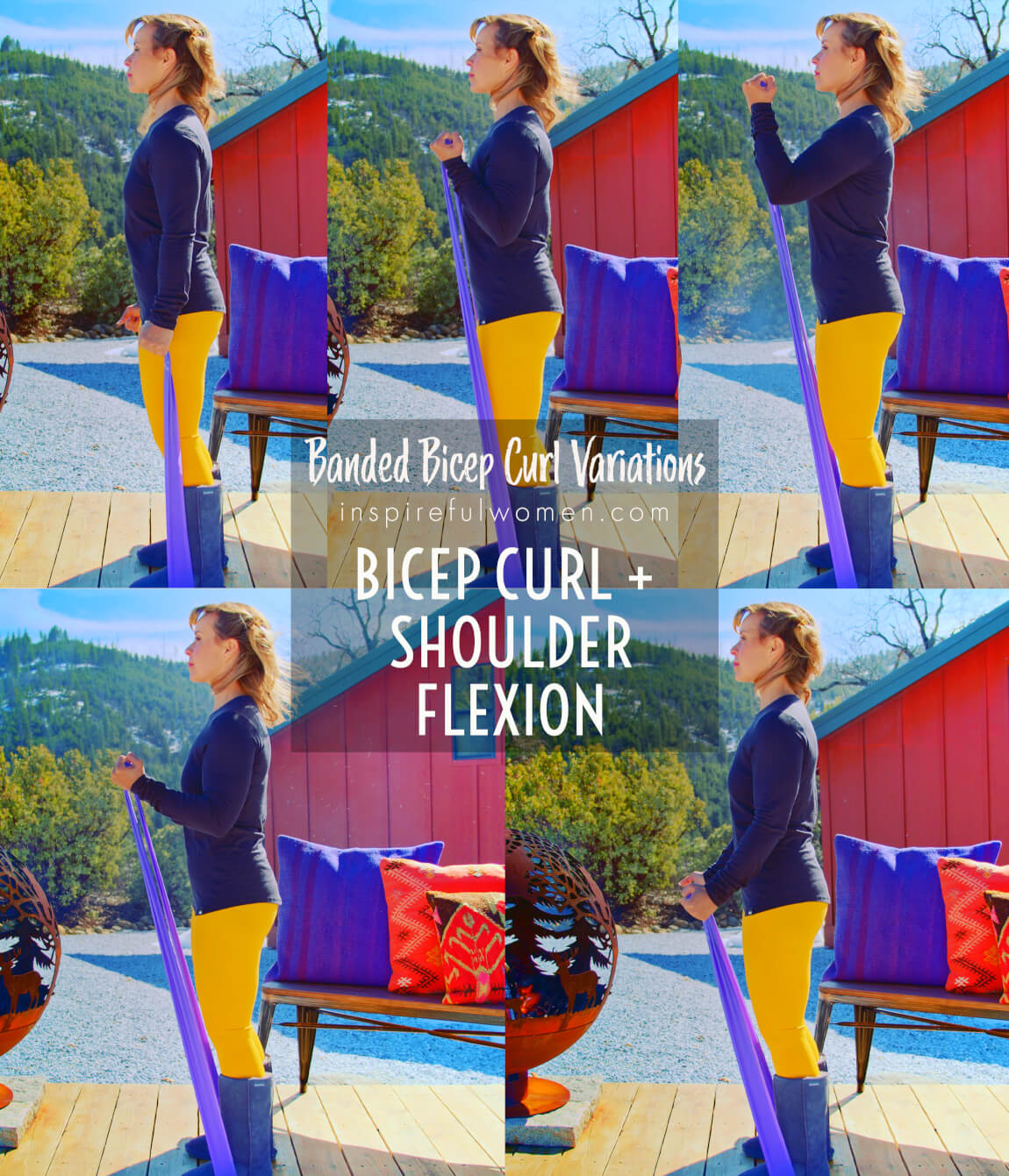
Single Arm
One arm banded bicep curl
This helps you train both arms equally. Holding the non working arm in the starting position (elbow straight) will let the muscles relax before exercising it; Optionally: hold the arm at the end range of the movement - elbow bent with forearm parallel to the floor - this will keep the muscles of the “non-working” arm under tension as the other arm completes its reps.
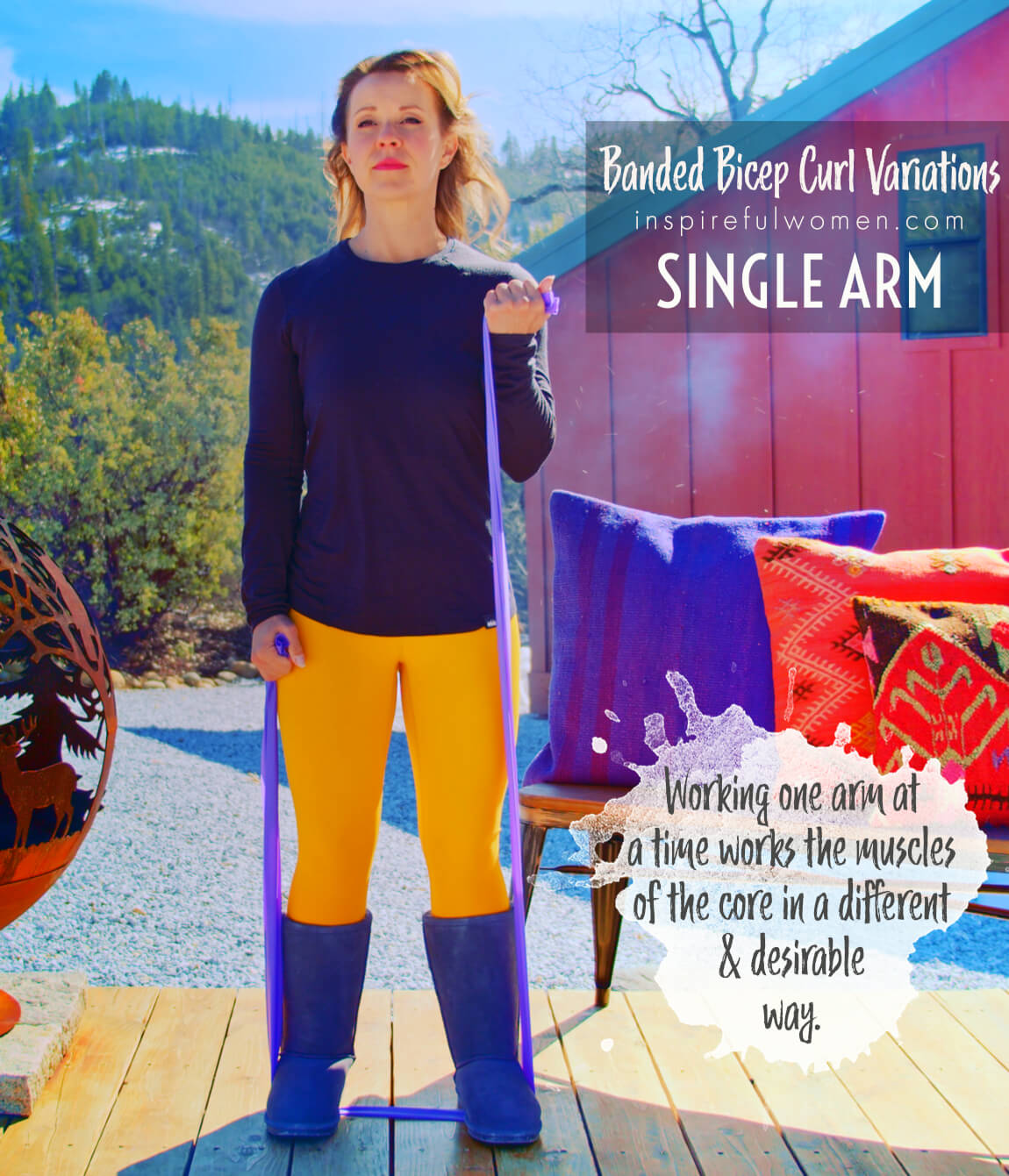
Alternating
Alternating band biceps curl
Work one arm at a time, alternating left and right. This will work the core muscles differently - the obliques and quadratus lumborum will be more active to stabilize against the uneven left and right loading. There are two options: 1) complete one rep on the right and then one rep on the left - this will allow each arm a short rest between reps, it will also put less demand on the core muscles so you may be able to use more resistance. 2) Bend one elbow, hold the bent elbow position, bend the other elbow and hold. Straighten the first arm, and then the second arm to complete the one rep. This will keep the biceps under tension for a longer period of time.

MAKE IT HARDER
HARDER
MAKING THE Band Biceps Curl MORE CHALLENGING
Isometric holds
Isometric hold band biceps curl
Isometric hold at 90 degrees of elbow bend (called elbow flexion).

Constant muscle tension
Constant muscle tension
Lifting the upper arm forward and holding the arm in slight flexion as you do the bicep curl. This will keep some tension on the biceps throughout the exercise. The arm is lifted so the elbows are about 4 inches from the torso.
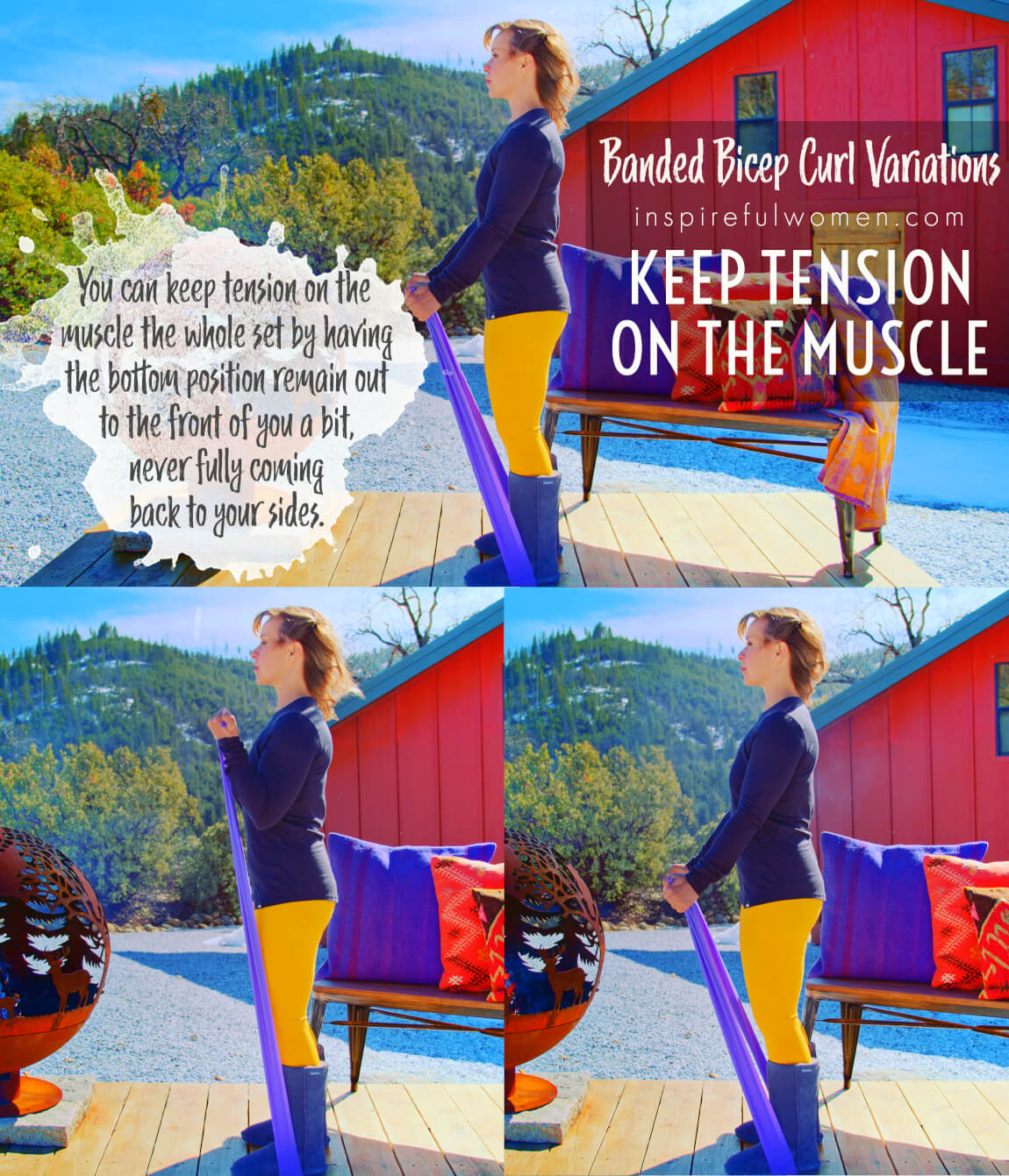
WHAT WE'RE DOING TODAY
WHAT & WHY
BENEFITS OF TRAINING THE Biceps
WHAT
The biceps brachii (bicep means that the muscle has two heads connecting at different places, and brachii - meaning arm) is the big muscle lying on the upper part of the front of the arm - between the elbow and the shoulder. This is probably the most well-known muscle of the arm - sometimes referred to as the beach muscle. The main function of the biceps brachii (not to be confused with the biceps femoris which is one of the hamstring muscles) is to bend (flex) the elbow, moving the hand closer to the body.
The biceps brachii also can rotate the forearm so that the palm is facing up. The rotation of the forearm is due to one of two long bones in the forearm rotating across the other. This is called supination.
Most of the exercises for the biceps muscle most effectively are movements that combine bending (flexing) the elbow with rotating the forearm to a palm-up position (supination). The bicep is a big, powerful muscle. Exercises that target this muscle can usually be done with quite a bit of resistance.
WHY BOTHER DOING IT?
WHY
WHY DO WE EVEN CARE?
Crossfitting for 8 years we never did specific bicep work, and most of the movements didn’t really work your biceps much. Once I started doing bicep curls regularly, I noticed a big difference. One day I needed to carry a 5-gallon bucket of stuff in each hand for quite a long distance. I was amazed at how much easier it felt than a while back! That’s from the biceps being stronger. This is also helpful for holding other things in your arms - a stack of books, children, getting all the groceries into the house in one trip, pulling heavy pans full of turkey and potatoes out of the oven, carrying a load of firewood, or a stack of lumber.
The biceps brachii crosses the shoulder joint, so it is able to lift the arm up (shoulder flexion). Since it crosses both the elbow and the shoulder it plays a role in stabilizing those joints. The job of the arm is to move the hand to where it needs to be, and then to hold the arm still as the hand does what it needs to do. The biceps is extremely important for both moving the arm through an endless number of positions and holding it still. Strong biceps will make everyday life activities easier and will improve the health of your elbows and shoulders.
EVERYDAY LIFE
EVERYDAY LIFE &
MUSCLE FUNCTION
HOW WE USE OUR biceps MUSCLES IN EVERYDAY LIFE
1. BENDING THE ELBOW (ELBOW FLEXION)
- Eating
- Lifting glass for drinking
- Dressing
- Lifting
- Carrying
- Washing/brushing hair
- Stirring
- Painting
- Brushing your teeth
- Weeding
- The list is pretty much endless...
2. TURNING YOUR FOREARM UP (SUPINATION)
- Turning a doorknob
- Using a screwdriver
- Turning a key
- Turning a spigot
- Receiving change
- Carrying a plate
3. LIFTING THE ARM (SHOULDER FLEXION)
- Reaching up
- Dressing
- Pushing a window up
- Washing windows
- Lifting up to the front - kids, boxes
- Carrying in front: kids, groceries, books
4. STABILIZING THE ELBOW AND SHOULDER
- Writing
- Knitting
- Reading a book
- Using a screwdriver
- Holding items in front of you - carrying a heavy box, pushing a wheelbarrow
HOW TO FEEL WHAT MUSCLE IS WORKING
How to Feel What Muscle is Working
SCIENCY STUFF
ALLLL MUSCLES & WHEN
ALL MUSCLES WORKING & WHEN DURING THE Band Biceps Curl
The biceps brachii and the brachialis, work concentrically to bend the elbow. The brachioradialis does not contribute unless power or speed is needed – for quicker movements or heavy loads.
The supinator will be active with the biceps brachii to supinate the forearm.. Wrist flexors (n palmaris longus, flexor carpi radialis, flexor carpi ulnaris) hold the wrist in neutral.
The biceps brachii and brachialis work eccentrically to straighten the elbow and return to the starting position.
PIN IT FOR LATER!
